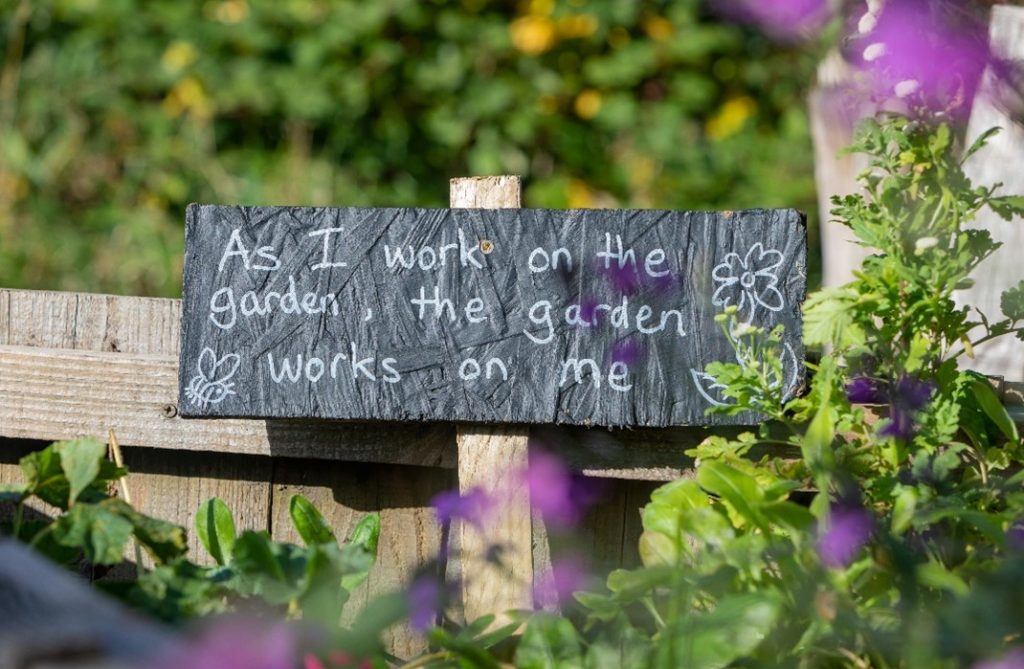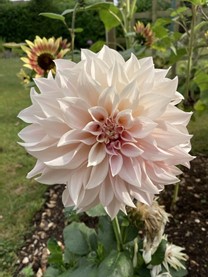To celebrate National Tree Week back in 2020 (seems so long ago now!), I spoke with several of my colleagues who also work with trees for wellbeing. The fourth person in the series was the lovely Clare Freemantle who lives in the same village as me, and who is taking her first exciting steps in setting up her own garden design business.
Gardening for Mental Health
Clare explains, “Gardening is enjoyed by millions of people around the UK and is well known as a popular hobby. However, more recently there has been wider interest in understanding the health and wellbeing benefits that can be gained. Research now demonstrates that exposure to plants and green space, and particularly gardening, is beneficial to mental and physical health”.
She’s very aware of the inequalities in access to green space as highlighted during the pandemic and is keen to point out that gardens and gardening can be enjoyed as part of a community project, through an allotment, on a balcony, on a windowsill, through houseplants or in your own private garden. It is not necessary to have a large garden of your own or to have vast horticultural knowledge to benefit.
Read on to find out more about Clare and garden design for wellbeing.
How it all Started
“My interest began as a child when I spent time in the garden with my grandmother, taking home small seedlings or unwanted plants to grow in my “patch” in my parent’s garden. When I first had a garden of my own, I had little knowledge, but I enthusiastically set to work. I had some success in creating an outdoor space for my young family to enjoy. Boy, what joy we had in digging our own potatoes, cooking, and eating them! And the sunflowers and dahlias were fabulous!
Returning to Education
As my children grew up, I became more and more passionate about the positive experiences we were enjoying. My skills were improving, and it dawned on me that if I could become professionally trained, I might be able to help others in creating these valuable spaces in their own gardens, whether for first-time homeowners, young families, house movers or retirees. It was time to return to education! 😁
In 2018, I attained a BSc in Horticulture with Plantsmanship and Design, an experience I thoroughly enjoyed. Subsequently, I joined the London College of Garden Design and completed their Construction Design Certificate. I have since set up Rosevale Garden Design, named after my grandmother’s cottage, and had great pleasure in creating peaceful spaces for relaxation, areas for socialising, balcony gardens and planting schemes, all developed individually, paying careful consideration to the client’s brief.
Green Space Benefits
These spaces offer clients, and their families or friends, exposure to plants and green space that are now proven to be so beneficial. Whether as a space to relax, to connect to nature or as an opportunity to garden, the benefits can include lowering stress and anxiety, giving a sense of calm, increasing fitness, improved levels of vitamin D and a sense of achievement, to name just a few.
How fantastic that a garden can not only look beautiful but also offer so much else besides.
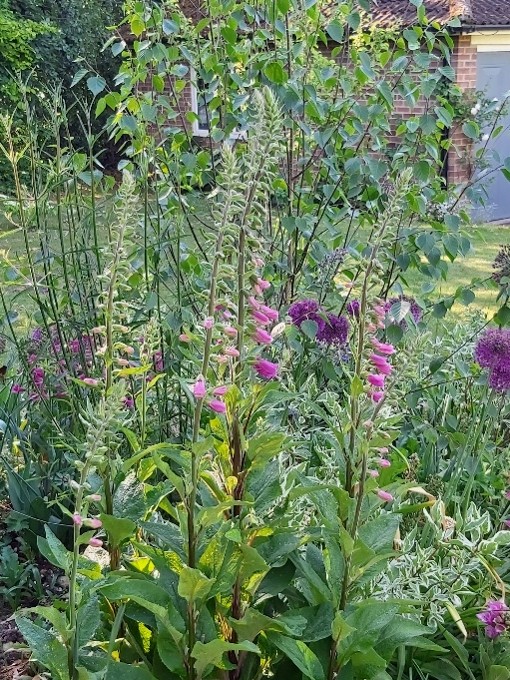
Sustainability in Garden Design
When planning gardens, I also keep an eye on the sustainability aspect. For example, where possible I source plants grown in peat-free compost, avoid the use of chemicals and fertilisers, and specify local materials, reassured that the impact on the environment has been considered (getting a big thumbs up from Sonya!).

You may have already experienced Sonya’s Forest Therapy, a technique centred around the mindfulness and relaxation practice known as Forest Bathing. I first heard about Shinrin-Yoku, as it is known in Japan, whilst studying for my degree. I am super keen to join Sonya to experience the Japanese practice and to deepen my connection to nature. Although I already immerse myself in nature regularly, I know that very often I pass by without truly letting go and giving myself time to be mindfully immersed.
The techniques used in Sonya’s sessions are practical skills that can be reused. With this in mind, it may be entirely possible to create the ‘essence of the forest’ in your own space if you do not have one already.
Tree Planting
If space allows, could you plant a tree in your own garden, with naturalistic underplanting, evoking a sense of peace and tranquillity? And of course, helping the environment too. For a smaller space, even a balcony, how about carefully selecting a tree that can thrive happily in a large pot? Alternatively, a bench in a quiet corner, surrounded by plants.
These additions will all allow observing the seasons; the colours, textures, sounds, and shapes, allowing you to help free your mind, a sensory technique regularly championed by Sonya.
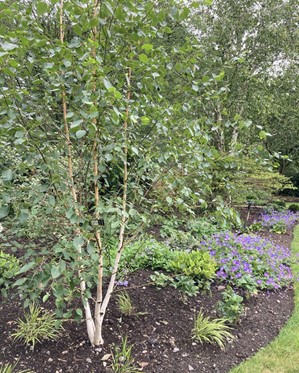
Should you wish to select a small garden tree, an excellent choice would be Betula (Silver birch), in particular, Betula utilis var. jacquemontii, offering delicate dappled shade in summer, perfect for escaping the hot summer sun. In winter, the tactile, intense white bark puts on a great display.

Alternatively, Malus (Crab apple) for prolific spring blossom and decorative fruits in autumn, that can either be harvested to make crab apple jelly or left for the birds to feast on through winter. Many different varieties are available, all attracting wildlife into the garden, another dimension to connecting with nature.
One of my favourites for excellent flaking bark, which curls back to reveal cinnamon bark beneath is Acer griseum, commonly known as the ‘Paperbark Maple’, fascinating and perfect for meditative observation. It is also prized for its brilliant autumn colour when the leaves turn to gorgeous shades of orange and scarlet 🍁
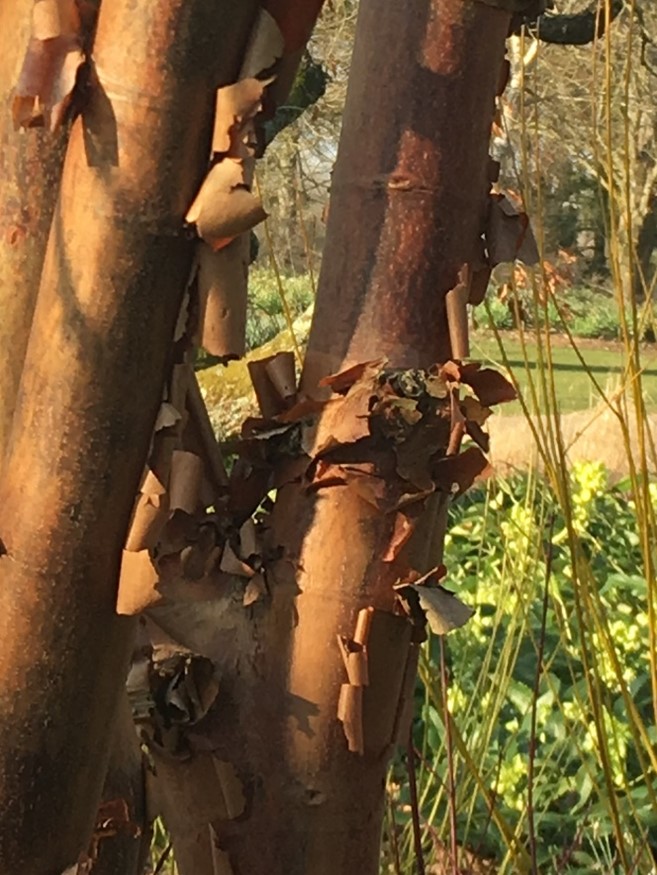
For a pot, how about a dwarf cherry tree, such as Prunus incisa ‘Kojo-no-mai? In early March it bursts into life with an abundance of bright white, delicate flowers with a pink centre. The foliage emerges bronze and then becomes a warm tone of orange in autumn.
Over the years I have noticed how being outside and nurturing plants made me feel ‘really good’ (not exactly a scientific term), bringing an enormous sense of enjoyment and achievement.
Sharing this pleasure with others brings me huge satisfaction”.
Garden Design Services
Some great tips and lovely to read your story – thank you, Clare! If you would like advice on developing your own tranquil space, suggestions for planting or a full garden design, Clare would be delighted to discuss this with you. She can work in a variety of ways depending on your needs.
She says, “I can offer guidance on a consultancy basis by visiting the garden with your, gathering information and subsequently report back giving you my suggestions and recommendations.
Alternatively, for a detailed planting design or complete garden design, I would measure the space, carry out a site analysis, take soil samples and importantly take note of your wishes. From this, I would create a design in line with your brief and present my ideas through design plans, mood boards and a planting schedule.
Also, if required I can help to bring designs to life by liaising with landscapers, sourcing plants, and overseeing the project to completion”.
Contact Clare
I don’t know about you but I am now chomping at the bit to design a garden 😁 Remember that if you can plant native species you will be given our native wildlife the best chance (and they need all the help they can get). To learn more or contact Clare, you can visit her website at www.rosevalegardendesign.co.uk or give her a call on 07789 722095.

I hope you’ve enjoyed this series of blog posts on ‘Working with Trees for Wellbeing’. Read the others which feature Ros and her incredibly helpful Bach flower remedies, Annika‘s magical essential oils and Fiona’s eco-friendly woodland burials.
